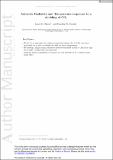Antarctic Radiative and Temperature Responses to a Doubling of CO 2
Author(s)
Freese, Lyssa M.; Cronin, Timothy W.
Download10.1029-2021GL093676.pdf (1.121Mb)
Open Access Policy
Open Access Policy
Creative Commons Attribution-Noncommercial-Share Alike
Terms of use
Metadata
Show full item recordAbstract
Greenhouse gases (GHGs), including carbon dioxide (urn:x-wiley:00948276:media:grl62786:grl62786-math-0001), impact global and local outgoing longwave radiation (OLR). The Antarctic is known for its near-surface temperature inversion, where the addition of GHGs can lead to increased OLR during all but the winter months. These changes in OLR, however, are unable to explain modeled surface warming due to changes in GHGs across central Antarctica. Here we develop a simple explanation showing why adding urn:x-wiley:00948276:media:grl62786:grl62786-math-0002 always warms the surface, and allowing an estimation of the change in surface temperature due to a change in urn:x-wiley:00948276:media:grl62786:grl62786-math-0003 concentration based on the initial surface temperature. We develop a radiative-advective-turbulent single-column model based on observed temperatures for explicit comparisons between our estimations and model equilibrium behavior. We confirm that Antarctic surface temperatures warm as GHG concentrations increase, and find that this response is best explained through the surface greenhouse effect rather than that of the top of atmosphere (TOA).
Date issued
2021-08-27Department
Massachusetts Institute of Technology. Department of Earth, Atmospheric, and Planetary SciencesJournal
Geophysical Research Letters
Publisher
American Geophysical Union (AGU)
Citation
Freese, L. M., & Cronin, T. W. (2021). Antarctic radiative and temperature responses to a doubling of CO2. Geophysical Research Letters, 48, e2021GL093676.
Version: Author's final manuscript
ISSN
0094-8276
1944-8007